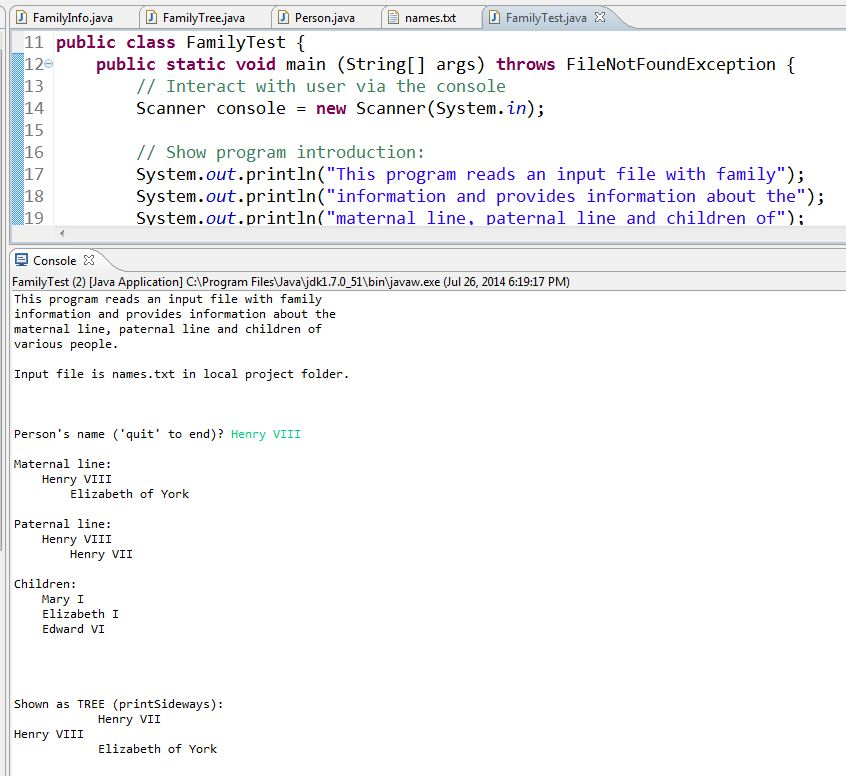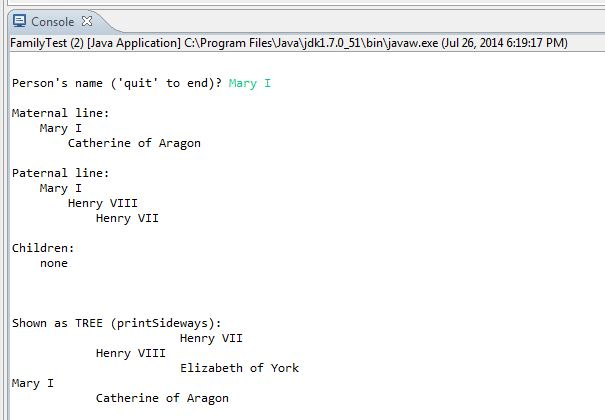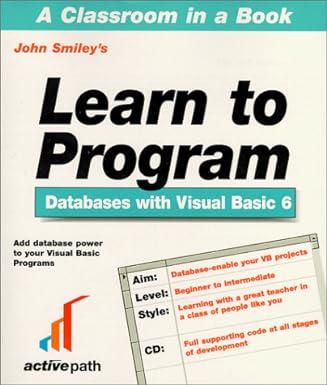Question
Chapter 10, page 699-700, Programming Project #3, Family database program: plus add a Family Tree Class. First complete this Chapter 10 ArrayList and then upgrade
Chapter 10, page 699-700, Programming Project #3, Family database program: plus add a Family Tree Class. First complete this Chapter 10 ArrayList and then upgrade into a FamilyTree Class as described below. I repeat: First complete Chapter 10 Project #3, 99% of the student questions are from those who skip that step!!! I've included the Person Class file from the BJP text author to give you a good start: Person.javaPreview the documentView in a new window After the Chapter 10 run displays as shown here: Capture1.JPGView in a new window These data come from the file names.txtPreview the documentView in a new window which is the exact same list of names provided by our text author back in Chapter 10 (tudor.dat), but modified for this assignment. In the above screen capture, please notice a few things. Note the upper output is identical to what's in the text, then at the bottom, I display the same data as a printSideways Tree. I also note that one of the children is Mary I, so I can enter that name too, and get the following family tree information: Capture2.JPGView in a new window The main() test program from the text author I've changed to FamilyTest.javaPreview the documentView in a new window which you cannot alter, as that's what I'll use to test your FamilyInfo and FamilyTree classes. The person names and family information are provided in a text file names.txtPreview the documentView in a new window which is simply a list of person-mother-father information that the text author has provided. Side note: the data from our text (tudor.dat) has the problem of assuming the first list of names will be exactly the same as the second list of names, no spelling errors or name variations, I avoid this by providing the list of names only once in names.txtPreview the documentView in a new window CRUCIAL: Download the names.txtPreview the documentView in a new window file into your project folder (not \src). You need to actually download this file (not the textbook version) and read the file as is, else you will create code that does not work with my file, and your code will fail all testing (ouch!!!). I will actually test code with a smaller version (8 names) of this same file. So don't let a surprise line feed, blank line, or extra new line kill your program. Try a smaller file!!! Your FamilyTree class should be a binary tree, similar to IntTree in the text, but Person replaces the int as data. This creates a tree of Person nodes. When the user selects a Person, the program builds a customized FamilyTree with that Person at the root, their mother on the left, and father on the right. Since the mother is also a Person, another valid sub-tree needs to be built for her, and another valid sub-tree off the father on the right. An unknown parent can be treated as a null. Upload your completed FamilyInfo.java and FamilyTree.java files when done. I will use FamilyTest.javaPreview the documentView in a new window and Person.javaPreview the documentView in a new window to test your submissions.
---------------------------------------------------------------------------------------------------------------------------------------------------------------
// This program tests the FamilyInfo and Person classes by reading a
// file with family information and showing the maternal line, paternal
// line and children for various people.
//
// Code extracted from Reges and Stepp, Building Java Programs
// modified by W.P. Iverson for CS211, February 2016
import java.io.*;
import java.util.*;
public class FamilyTest {
public static void main (String[] args) throws FileNotFoundException {
// Interact with user via the console
Scanner console = new Scanner(System.in);
// Show program introduction:
System.out.println("This program reads an input file with family");
System.out.println("information and provides information about the");
System.out.println("maternal line, paternal line and children of");
System.out.println("various people. ");
// Read given family information into FamilyInfo object
Scanner input = new Scanner(new File("names.txt"));
System.out.println("Input file is names.txt in local project folder.");
FamilyInfo family = new FamilyInfo();
family.read(input); // BIG method, that reads data file into object
input.close(); // all data in file is read, so file is no longer needed
// Loop main program as long as user desires:
String name = "Keep running";
while(!name.equals("quit")) {
System.out.print(" Person's name ('quit' to end)? ");
name = console.nextLine(); // read line from user
System.out.println();
if (name.equalsIgnoreCase("quit")) break; // break loop upon quit
Person next = family.getPerson(name);
if (next == null) {
System.out.println("No match.");
} else {
showMaternal(next);
showPaternal(next);
showChildren(next);
System.out.println(" Shown as TREE (printSideways):");
FamilyTree structure = new FamilyTree(next);
structure.printSideways();
}
}
console.close();
}
// Shows maternal ancestors for given person
public static void showMaternal(Person current) {
System.out.println("Maternal line:");
int level = 1;
while (current != null) {
for (int i = 0; i
System.out.print(" ");
}
System.out.println(current.getName());
current = current.getMother();
level++;
}
System.out.println();
}
// Shows paternal ancestors for given person
public static void showPaternal(Person current) {
System.out.println("Paternal line:");
int level = 1;
while (current != null) {
for (int i = 0; i
System.out.print(" ");
}
System.out.println(current.getName());
current = current.getFather();
level++;
}
System.out.println();
}
// Shows children for given person
public static void showChildren(Person current) {
System.out.println("Children:");
if (current.getChildren().size()== 0) {
System.out.println(" none");
} else {
for (int i = 0; i
System.out.println(" " + current.getChildren().get(i).getName());
}
System.out.println();
}
}
}
----------------------------------------------------------------------------------------------------------------------------
CHILD/MOTHER/FATHER records follow:
-
Arthur
Elizabeth of York
Henry VII
-
Henry VIII
Elizabeth of York
Henry VII
-
Margaret
Elizabeth of York
Henry VII
-
Mary
Elizabeth of York
Henry VII
-
Mary I
Catherine of Aragon
Henry VIII
-
Elizabeth I
Anne Boleyn
Henry VIII
-
Edward VI
Jane Seymour
Henry VIII
-
James V
Margaret
James IV
-
Mary, Queen of Scots
Mary of Guise
James V
-
James VI & I
Mary, Queen of Scots
Henry, Lord Darnley
-
Frances
Mary
Charles Brandon
-
Lady Jane Grey
Frances
Henry Grey
-
Henry, Lord Darnley
Margaret Stuart
unknown
-
Margaret Stuart
Margaret
unknown
-
END OF FILE
-------------------------------------------------------------------------------------------------------------------------------------------
// Class Person records the name and immediate blood relations of an
// individual (mother, father, children).
import java.util.*;
public class Person {
private String name;
private Person mother;
private Person father;
private ArrayList
// post: constructs a person object with no family links
public Person(String name) {
this.name = name;
this.children = new ArrayList
}
// post: returns this person's name
public String getName() {
return this.name;
}
// post: returns this person's mother (null if not known)
public Person getMother() {
return this.mother;
}
// post: returns this person's father (null if not known)
public Person getFather() {
return this.father;
}
// post: returns this person's list of children
public ArrayList
return this.children;
}
--------------------------------------------------------------------------------------------------------------------------------------------------


Step by Step Solution
There are 3 Steps involved in it
Step: 1

Get Instant Access to Expert-Tailored Solutions
See step-by-step solutions with expert insights and AI powered tools for academic success
Step: 2

Step: 3

Ace Your Homework with AI
Get the answers you need in no time with our AI-driven, step-by-step assistance
Get Started


